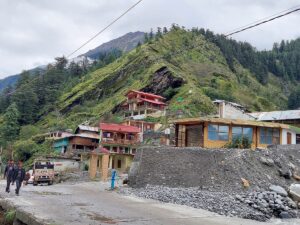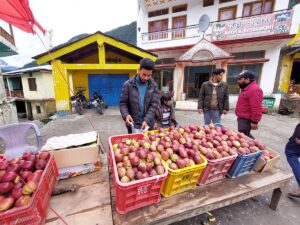[dropcap]T[/dropcap]he devastation brought by the massive flash flood of 2025 at Khirganga Gad in Dharali is heartbreaking. Once a peaceful village nestled just off the highway with serene access to the Bhagirathi, Dharali stood as a gateway to the majestic Harsil Valley, surrounded by snow-clad peaks and breathtaking vistas. Numerous small streams in the region, including Khirganga—a natural gad or mountain stream—flowed gracefully into the Bhagirathi, shaping the landscape and sustaining life.
The village, just 6 km from the more well-known Harsil, often left a deeper impression on visitors. A small market here served as a resting point for pilgrims headed to Gangotri Dham. Nearby stood the ancient Kalp Kedar temple on the riverside, quietly testifying to the region’s spiritual and cultural depth.
But now, all that beauty is scarred. The same Khirganga stream, usually quiet and harmless, turned furious—its natural flow obstructed by years of unchecked construction and concrete encroachment. History has shown us repeatedly that the greatest devastations in the Himalayas come not from rivers, but from these seemingly minor gads and gaderas. Their space is increasingly stolen by buildings, roads, and resorts, built in haste to meet the unrelenting demands of mass tourism.
Blinded by Development, Ignoring the Warnings
The pressure of the Char Dham Yatra has long overwhelmed the fragile ecosystems of Uttarakhand. Tourists, who now travel not as pilgrims but as consumers, demand cheap, comfortable accommodations—replicas of their urban conveniences in the remotest Himalayan corners. Many even claim that they are the lifeline of Uttarakhand’s economy, justifying the ever-expanding infrastructure.
But at what cost?
Scientists have disputed the cloudburst theory in this disaster. According to The Times of India, there was no significant rainfall in Harsil, Mukhba, or Gangotri. Experts suggest the possibility of a Glacial Lake Outburst Flood (GLOF), among the most dangerous threats in the region. The report notes that there are 1,266 glacial lakes in Uttarakhand—13 of which are classified as high risk.

We have been here before. The glacial burst near the Nanda Devi massif not long ago triggered massive destruction at the Rishi Ganga-Dhauliganga confluence near Reni—the birthplace of the Chipko Movement.
Currently, reports are also emerging of an artificial lake forming near the Harsil army base—also impacted by the recent flash floods. The Army has stepped in for rescue operations despite challenges posed by terrain and continuing disasters. Dharali is now completely cut off. Rescue teams are stuck, landslides are rampant, and the National Highway has collapsed in multiple locations.
Resistance Ignored, Nature Responds
In 2024, the government approved the widening of the Gangotri Highway between Harsil and Gangotri—despite protests and violations of environmental norms. Thousands of Deodar trees were marked for felling. The Hindustan Times (August 29, 2024) documented local resistance:
“The entire road widening project in the eco-sensitive zone violates the Ravi Chopra Committee’s findings. BRO claims these areas are not eco-sensitive. How is that possible? We want better roads, yes, but not at the cost of our forests. This region is extremely prone to landslides,” said Pushpa Chauhan, former gram pradhan of Bhatwari.
This region—stretching 135 km from Uttarkashi to Gaumukh—was declared an Eco Sensitive Zone (ESZ) by the central government in 2010. A final notification came in 2012. Politicians called it “anti-development.” Yet today, the same “development” threatens the region’s existence.

The Supreme Court recently warned that Himachal Pradesh might vanish from the map if corrective steps aren’t taken. Uttarakhand faces a similar fate. Rapid urbanisation, tourist influx, and mushrooming of stay-homes, hotels, and resorts—mostly owned by businessmen from cities like Delhi and Chandigarh—have burdened locals without offering sustainable employment.
Local workers do the heavy lifting during the yatra season, while profits fly elsewhere.
Lawless Growth, Predictable Disaster
Years ago, the Supreme Court and NGT had barred construction within 50 meters of rivers in hilly terrain, designating it as a Prohibitory Zone, and up to 100 meters as a Regulatory Zone. Yet violations continue. The National Green Tribunal (NGT) made it clear in 2017 and reiterated in 2021: no construction on floodplains, no development on riverbeds. But just visit towns along the Ganga in Uttarakhand—you’ll find resorts and hotels standing on riverbeds. Who permits them?
Every time a disaster occurs, we call it a “wake-up call.” And then we go back to sleep.
Concretisation, hydropower projects, tunnel drilling, unchecked mass tourism in the name of Chardham and Kanwar Yatra—these are breaking the Himalayas. The pilgrimage has turned into a religious picnic, where reverence for nature is replaced with selfies and shouting.
Kedarnath was built to host 1,000 people. Now it hosts 20–30 times that number on peak days, crumbling under the weight of faith turned frenzy.
We understand the need for development. But we also need protection. The Himalayas are not just mountains. They are borders, ecosystems, and sacred spaces. They feed our rivers. They nurture us in life, and they liberate us in death.
Yet we treat them like a market.
No construction on riverbeds. Enforce NGT orders. Regulate the yatra. Protect forests. Stop building roads through landslide-prone zones. These are not radical demands. They are necessities for survival.
Dharali’s tragedy should not be just another news item. It must be the moment that compels policymakers to act.
We extend our deepest condolences to those who https://estudiosociologicos.org/portal/ lost their loved ones. A heartfelt salute to the brave soldiers, NDRF, and SDRF teams who are risking their lives to save others. The people of Uttarakhand deserve better—not just sympathy, but a sincere and sustainable plan that respects their land, their lives, and their legacy.
Let’s hope Dharali becomes the last wake-up call.


